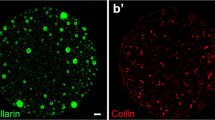Abstract
The time course of meiotic amplification of nucleolar DNA in Xenopus laevis oocytes has been studied autoradiographically. We find that the process is first detectable in zygotene nuclei less than 7 days after the end of premeiotic S-phase. It is completed 3 1/2 weeks later, towards the end of pachytene. Premeiotic S-phase lasts for 1–2 weeks. We are not certain whether it is followed by a short G2 or whether leptotene commences immediately. Leptotene lasts for 5±2 days, zygotene for 7±2 days and pachytene for about 20 days before the oocyte gradually enters the extended diplotene stage. Various molecular mechanisms for amplification are discussed in the light of a 24±3 day amplification time. All are found to be potentially capable of amplifying sufficient nucleolar DNA in the time available.
Similar content being viewed by others
References
Adamick, E. R.: Laboratory procedures for tritium autoradiographs. (Available from Schwarz Bioresearch, Inc.)
Brown, D. D., Dawid, I. B.: Specific gene amplification in oocytes. Science 160, 272–280 (1968).
Callan, H. G., Taylor, J. H.: A radioautographic study of the time course of male meiosis in the newt Triturus vulgaris. J. Cell Sci. 3, 615–626 (1968).
Evans, D., Birnstiel, M. L.: Localisation of amplified ribosomal DNA in the oocyte of Xenopus laevis. Biochim. biophys. Acta (Amst.) 166, 274–275 (1968).
Gall, J. G.: Differential synthesis of the genes for ribosomal RNA during amphibian oogenesis. Proc. nat. Acad. Sci. (Wash.) 60, 553–560 (1968).
—: The genes for ribosomal RNA during oogenesis. Genetics 61, Suppl., 121–132 (1969).
—, Pardue, M. L.: Formation and detection of RNA-DNA hybrid molecules in cytological preparations. Proc. nat. Acad. Sci. (Wash.) 63, 378–383 (1969).
Gallien, L.: Inversion totale du sexe chez Xenopus laevis Daudin à la suite d'un traitement gynogené par le benzoate d'∁stradiol, administré pendant la vie larvaire. C.R. Acad. Sci. (Paris) 237, 1565–1567 (1953).
Macgregor, H. C.: Nucleolar DNA in oocytes of Xenopus laevis. J. Cell Sci. 3, 437–444 (1968).
Miller, O. L.: Structure and composition of peripheral nucleoli of Salamander oocytes. In: International Symposium of the nucleolus—ist structure and function (W. S. Vincent and O. L. Miller, eds.). Nat. Cancer Inst. Monogr. 23, 53–66 (1965).
Perkowska, E., Macgregor, H. C., Birnstiel, M. L.: Gene amplification in the oocyte nucleus of mutant and wild-type Xenopus laevis. Nature (Lond.) 217, 649–650 (1968).
Tocchini-Valentini, G. P., Crippa, M.: On the mechanism of gene amplification. In: Lepetit, Colloquia on Biol. and Med., vol. 2. Amsterdam: North Holland Press 1971.
Wallace, H., Morray, J., Langridge, W. H. R.: Alternative model for gene amplification. Nature New Biology 230, 201–203 (1971).
Author information
Authors and Affiliations
Rights and permissions
About this article
Cite this article
Bird, A.P., Birnstiel, M.L. A timing study of DNA amplification in Xenopus laevis oocytes. Chromosoma 35, 300–309 (1971). https://doi.org/10.1007/BF00326280
Received:
Accepted:
Issue Date:
DOI: https://doi.org/10.1007/BF00326280




